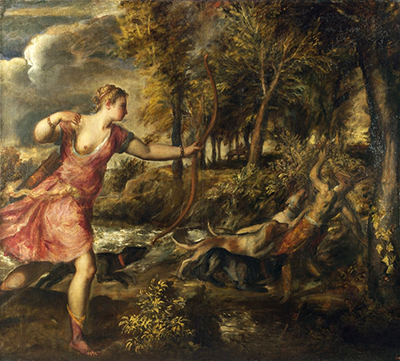Titian's continued his series of paintings for Philip II with The Death of Actaeon which is loosely dated at 1559-75
The reasons behind Actaeon's punishment were previously covered in the other elements of this series, in Diana and Actaeon and Diana and Callisto. Actaeon had rudely interupted goddess Diana and her nymphs, arriving at a time where she was even semi-naked. Her fury would be realised in this final part of the series, with Actaeon turned into a stag. His own hounds would later attack and kill him.
The series was inspired, and fairly faithful to Roman poet Ovid's Metamorphoses. This painting was the one element of the project which was never delivered to Philip II, remaining in the artist's studio right up until his death. It is believed that he was unhappy with certain elements of it and had therefore not allowed it to be considered at that point.
Titian used a certain degree of artistic license in each of these works, choosing to display a more aggressive Diana than perhaps had originally been described by Ovid. She clearly is chasing her target in this depiction, contrasting with how he had originally written this story.
The National Gallery in London possess this painting amongst a fine collection of Renaissance art, including several other paintings from Titian himself. The National Galleries of Scotland joined forces with this institution to buy the artworks together and they continue to rotate them between the two galleries as part of the agreement made at the time.
There is a wealth of art from other fine artists here too, such as The Fighting Temeraire by JMW Turner, Supper at Emmaus by Caravaggio, The Ambassadors by Hans Holbein, The Virgin of the Rocks by Leonardo da Vinci and The Judgement of Paris by Peter Paul Rubens, to name just a few.




